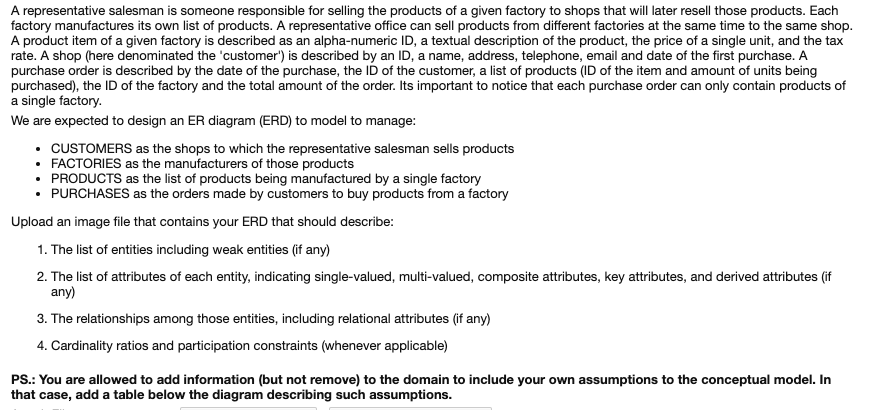A representative salesman is someone responsible for selling the products of a given factory to shops that will later resell those products. Each factory manufactures its own list of products. A representative office can sell products from different factories at the same time to the same shop. A product item of a given factory is described as an alpha-numeric ID, a textual description of the product, the price of a single unit, and the tax rate. A shop (here denominated the 'customer') is described by an ID, a name, address, telephone, email and date of the first purchase. A purchase order is described by the date of the purchase, the ID of the customer, a list of products (ID of the item and amount of units being purchased), the ID of the factory and the total amount of the order. Its important to notice that each purchase order can only contain products of a single factory. We are expected to design an ER diagram (ERD) to model to manage: • CUSTOMERS as the shops to which the representative salesman sells products • FACTORIES as the manufacturers of those products • PRODUCTS as the list of products being manufactured by a single factory • PURCHASES as the orders made by customers to buy products from a factory Upload an image file that contains your ERD that should describe: 1. The list of entities including weak entities (if any) 2. The list of attributes of each entity, indicating single-valued, multi-valued, composite attributes, key attributes, and derived attributes (if any) 3. The relationships among those entities, including relational attributes (if any) 4. Cardinality ratios and participation constraints (whenever applicable) PS.: You are allowed to add information (but not remove) to the domain to include your own assumptions to the conceptual model. In that case, add a table below the diagram describing such assumptions.
Control structures
Control structures are block of statements that analyze the value of variables and determine the flow of execution based on those values. When a program is running, the CPU executes the code line by line. After sometime, the program reaches the point where it has to make a decision on whether it has to go to another part of the code or repeat execution of certain part of the code. These results affect the flow of the program's code and these are called control structures.
Switch Statement
The switch statement is a key feature that is used by the programmers a lot in the world of programming and coding, as well as in information technology in general. The switch statement is a selection control mechanism that allows the variable value to change the order of the individual statements in the software execution via search.

Trending now
This is a popular solution!
Step by step
Solved in 2 steps with 1 images




